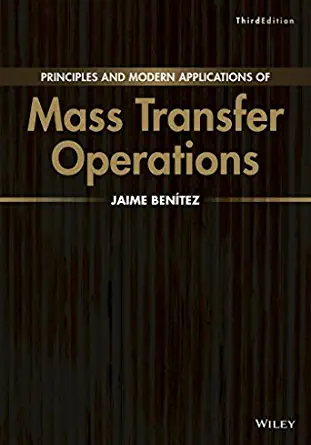
Sugarcane juice can be thought of as a solution of water \& sucrose (a disaccharide of glucose \& fructose, C12H22O11 ). Let us look at a material balance around a batch fermenter for sugarcane juice. Consider the following: - The sugarcane juice is 15wt% sucrose. At this concentration, the specific gravity is 1.061. - Each fermenter is 380m3 batch fermenter filled to 85% at the beginning of the fermentation. - The fermentation is carried out long enough to consume 90% of the sucrose and convert to ethanol. Another 5% is consumed for cell growth (assume this is just sucrose consumption with no water consumption or production). The final 5% is unreacted. - The overall cycle time is 72 hours. This is the total time between start of fermentation, end of fermentation, emptying, cleaning, \& refilling.) Determine the following: a) The chemical reaction given in the textbook (Example 14.1) is not fully balanced. Present a fully balanced reaction to account for sucrose being fermented to ethanol \& CO2. b) Based on the specific gravity of the sugarcane juice what is the effective liquid specific gravity of sucrose? (Consider that the density for the solid is 1.6g/cm3; you would expect the effective liquid density to be similar but not necessarily the same.) c) Using specific gravity of the sugarcane juice, how much sucrose \& water is charged to the fermenter (in both kg&kmole )? What is the sugar concentration at the beginning of the fermentation (in kg sucrose per m3 solution)? d) Assume that at the end of the fermentation the liquid only contains water, ethanol, \& residual sucrose; consider the produced CO2 is fully evolved to the gas phase \& stripped from the fermentation broth (but only the CO2 goes to the gas \& none of the ethanol). How much ethanol \& CO2 are created during the fermentation (in kg \& kmole)? What are the mass fractions of ethanol, water, \& sucrose in the fermentation broth at the end of the fermentation? e) What is the volume of the broth at the end of the fermentation (in m3 )? Consider an ideal liquid solution for the volume of ethanol (specific gravity 0.789), water, \& residual sucrose (use effective liquid specific gravity found previously). What is the volumetric fraction of ethanol in the water? f) What is the time-average production rate (in m3/ day)? g) If we want to produce 110m3/ day then how many fermenters are needed







